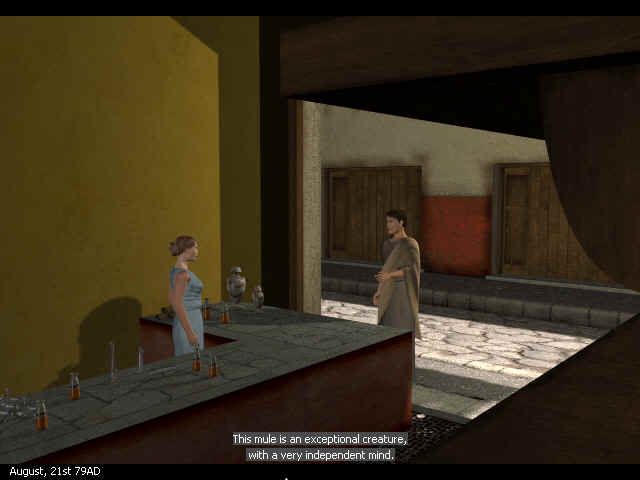Retro Replay Review
Gameplay
TimeScape: Journey to Pompeii delivers a blend of fast-paced action, intricate puzzle-solving, and time-sensitive decision-making that keeps players constantly on their toes. The core mechanic—racing against the imminent eruption of Mount Vesuvius—creates a genuine sense of urgency. From scaling crumbling ruins to navigating busy Roman streets, every moment feels critical. Combat sequences are responsive, with light weaponry and improvised tools adding variety to each encounter.
(HEY YOU!! We hope you enjoy! We try not to run ads. So basically, this is a very expensive hobby running this site. Please consider joining us for updates, forums, and more. Network w/ us to make some cash or friends while retro gaming, and you can win some free retro games for posting. Okay, carry on 👍)
Beyond combat, the game’s puzzle design shines. Ancient scrolls and cryptic inscriptions scattered throughout Pompeii demand careful observation and logical deduction. Players must piece together artifacts and decode symbols to unlock hidden pathways or gain vital information about Sophia’s whereabouts. These puzzles are challenging but fair, offering optional hints for those who prefer a smoother experience.
Exploration is richly rewarded. As Adrian traverses the city, he uncovers secret chambers, hidden dialogues, and collectible fragments of Pompeian life—letters, pottery shards, and fresco sketches—that deepen immersion. The parkour-style movement system is intuitive, allowing you to climb walls, leap across rooftops, and shimmy along ledges with fluid animations. Mastering these traversal mechanics is immensely satisfying, especially when racing the clock.
Graphics
Visually, TimeScape: Journey to Pompeii is a feast for the eyes. The reconstruction of Pompeii before the volcanic apocalypse is painstakingly detailed: sunlit villas gleam with marble, mosaics line walkways, and bustling marketplaces feel alive with vendors and townsfolk. Dynamic lighting brings the city to life, casting dramatic shadows through colonnades and glowing warmly at dusk.
When the eruption begins, the graphical fidelity ramps up impressively. Ash clouds billow realistically, embers drift through the air, and rivers of lava peel through streets in horrifying slow motion. Particle effects during tremors and collapses add tension, as dust and debris swirl around the player. The contrast between the serene pre-eruption world and the chaotic aftermath is stark and emotionally impactful.
The character models, particularly Adrian and Sophia, exhibit nuanced facial animations and expressive gestures. Ishtar’s ethereal form shimmers with divine luminescence, her eyes conveying both seduction and wrath. NPCs in Pompeii go about their days in believable routines, reacting dynamically to environmental changes—some flee in panic, others drop what they’re carrying as tremors start. This attention to detail enhances the authenticity of the historical setting.
Story
TimeScape’s narrative thrust is both epic and intimate. Adrian Blake’s journey begins humbly—a soldier trapped in a cave, grappling with fear and loss—and escalates into a desperate race to save his beloved Sophia in ancient Pompeii. The goddess Ishtar’s ominous bargain and her capricious curses add layers of mythological intrigue that complement the historical backdrop. Rejecting Ishtar’s initial advances establishes Adrian as a principled hero, and his subsequent quest to redeem himself feels deeply personal.
The writing balances action with emotional beats. Conversations with Sophia, who initially perceives Adrian as a stranger, are tender and at times achingly vulnerable. Their relationship develops organically through dialogue choices and shared trials, making the player’s investment in their fate genuine. Encounters with Romans—soldiers, merchants, and artisans—reveal slices of daily life, grounding the supernatural plot in human experience.
The four-day countdown to Vesuvius’s eruption anchors the narrative tension. Side quests, such as rescuing trapped citizens or deciphering age-old scrolls, tie back into the main storyline, enriching the lore without feeling like filler. Ishtar’s intermittent interventions—visions, cryptic riddles, and sudden storms—remind players of her divine power and malevolent whims. The climax, set against the backdrop of an exploding volcano, delivers a satisfying blend of tragedy, heroism, and catharsis.
Overall Experience
TimeScape: Journey to Pompeii stands out as a captivating blend of history, mythology, and action-adventure. Its seamless integration of time-pressure mechanics with narrative stakes ensures that players remain engaged from start to finish. Whether you’re dashing across rooftops to outrun a pyroclastic flow or piecing together ancient puzzles in dimly lit catacombs, the game constantly delivers fresh challenges and emotional payoffs.
Replay value is significant. Multiple dialogue paths with Sophia and branching puzzle solutions invite second playthroughs. Players curious about alternate outcomes—what if you accept Ishtar’s offer?—are rewarded with new cutscenes and endings. Collectibles scattered throughout Pompeii unlock concept art and developer journals, offering deeper insights into the game’s design and historical research.
From its lush, crumbling cityscape to its sweeping mythic storyline, TimeScape: Journey to Pompeii offers a memorable, heart-pounding adventure. Whether you’re drawn by the thrill of racing against a volcano or enamored with its tragic love story, this title delivers on both fronts. For fans of action-adventure, historical settings, and narrative-driven games, it’s an experience not to be missed.
 Retro Replay Retro Replay gaming reviews, news, emulation, geek stuff and more!
Retro Replay Retro Replay gaming reviews, news, emulation, geek stuff and more!









Reviews
There are no reviews yet.